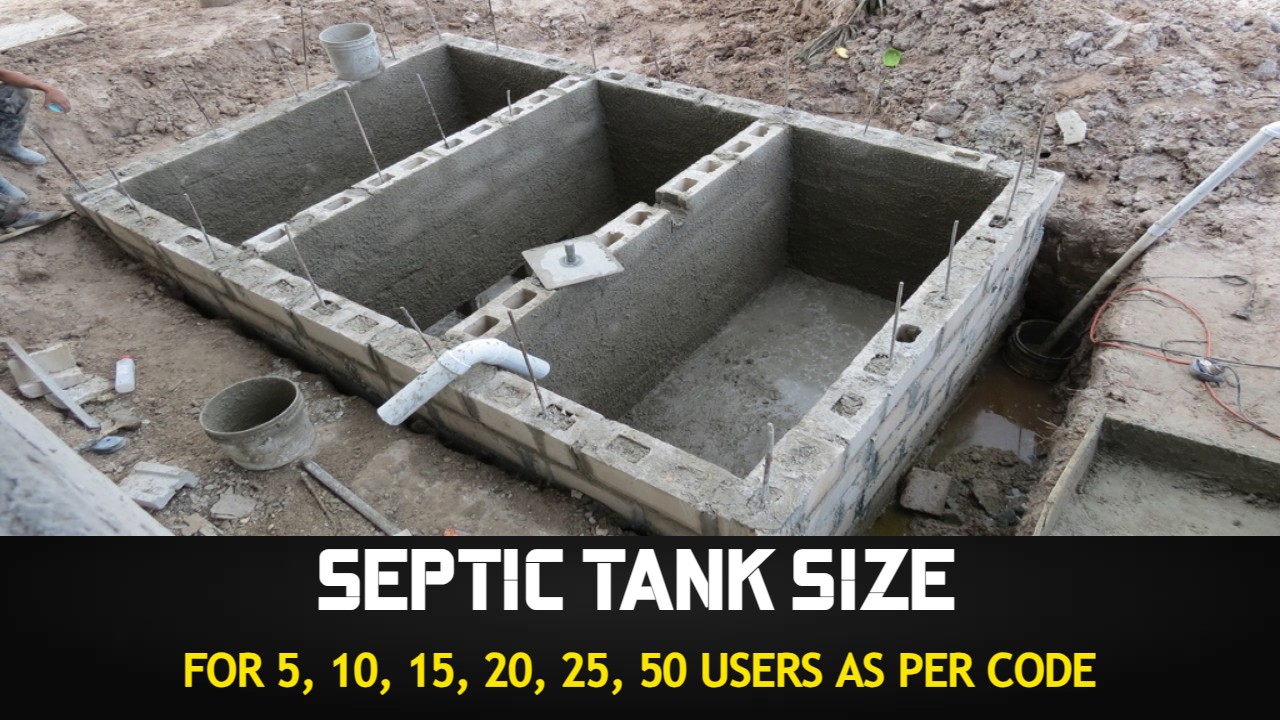An underground, on-site wastewater treatment system known as a septic tank is frequently utilised in places lacking access to a centralised sewage system. It offers a way to handle and get rid of wastewater and sewage from the home on the actual land. The wastewater may then be further processed and discharged into the soil through a drain field thanks to the solids and liquid separation capabilities of septic tanks, which are commonly composed of concrete or plastic.
Contents
- 1 What is Septic Tank?
- 2 How Does a Septic Tank Work?
- 3 What are Types of Septic Tank?
- 4 Recommended size of Septic Tanks for 5, 10, 15, and 20, 25, 50 Users as per IS 2470
- 5 Septic Tank Details
- 6 Septic Tank Parameters
- 7 How to Calculate the Size of Septic Tank?
- 8 Septic Tank Size for Residential Building
- 9 Septic Tank size for 4 users
- 10 Septic Tank size for 5 users
- 11 Septic tank size for 6 users
- 12 Septic tank size for 10 users
- 13 Septic tank size for 15 users
- 14 Septic tank size for 20 users
- 15 Septic tank size for 25 users
- 16 Septic tank size for 30 users
- 17 Septic tank size for 50 users
- 18 Reference Videos for Septic Tank
- 18.1 What is Septic tank, Sewage, Sludge, Detention Tank | How Septic Tank Works
- 18.2 How to Study Septic Tank Drawing | Plan and Section of Septic Tank
- 18.3 Septic Tank Capacity and Dimensions per User
- 18.4 Recommended size of Septic Tanks for 20 Users
- 18.5 Septic Tank Size for Hostels and Boarding Schools
- 18.6 Septic Tank Size for Residential Colonies
- 18.7 Volume Calculation and Minimum Size of Circular Septic tank
- 18.8 25 Important Points Must Remember Before Septic Tank Construction
- 18.9 Slope Calculation of Septic tank in two ways
- 18.10 Basic 14 Important Points to Remember Before Septic Tank Design
- 18.11 Soak Pit Construction for House | घर के लिए Sewage Pit कैसे बनाये?
- 19 Conclusion
- 20 Frequently Asked Questions – FAQs
- 20.1 How often should a septic systems be pumped?
- 20.2 Can I use additives to maintain my septic systems?
- 20.3 How can I tell if my septic system is failing?
- 20.4 Can I build over my septic tank or drain field?
- 20.5 Can I plant trees near my septic system?
- 20.6 Is it safe to use a garbage disposal with a septic tank?
- 20.7 Can I use septic-safe cleaning products?
- 20.8 Can heavy rainfall affect my septic system?
- 20.9 Can I repair a failing septic system myself?
- 20.10 Are septic systems allowed in urban areas?
What is Septic Tank?
A septic tank is a waterproof container used to collect and treat wastewater from homes and businesses. It serves as a primary treatment unit, separating the particles from the liquid component (effluent), allowing it to go through additional processing before being safely released into the soil.
Also Read: What is Septic tank, Effluent, Scum, Sewage, Detention Tank, Aerobic and Anaerobic Bacteria
How Does a Septic Tank Work?
In order to process and dispose of wastewater from residential or commercial structures, septic tanks are an essential part of septic systems. This is how a septic tank functions:
Wastewater Collection: A main drainpipe directs all wastewater produced in the building, including that from toilets, sinks, showers and laundry, into the septic tank.
Separation of Solids and Liquids: The wastewater is separated once it has entered the septic tank. Two chambers or compartments make up the tank, and a pipe at the intake directs flow into the first chamber.
Primary Treatment: The heavier materials sink to the bottom of the first chamber, sometimes referred to as the main chamber, where they create a layer of sludge. Grease and oils, which are lighter substances, float to the surface and form a layer of scum. The middle layer is occupied by the residual liquid, sometimes referred to as effluent.
Anaerobic Digestion: Anaerobic digestion, a natural breakdown process carried out by bacteria present in the tank, is how solid waste is broken down inside the septic tank. This procedure aids in the organic matter’s breakdown and volume reduction.
Effluent Discharge: The treated effluent is pushed towards the second chamber as fresh wastewater enters the tank and pushes the old wastewater aside. The wastewater then moves on to the following step of treatment, which is often in a drain field or leach field.
Further Treatment and Disposal: In the drain field, where it percolates through the earth, the effluent exits the septic tank. By filtering out dangerous bacteria, viruses, and nutrients, the soil serves as a natural supplemental therapy. The cleaned wastewater is eventually safely absorbed into the groundwater.
The septic tank only performs primary treatment by separating particles from liquids, which is a crucial distinction to make. To guarantee effective sewage disposal and avoid groundwater pollution, the effluent needs extra treatment in the drain field.
Regular maintenance is necessary to keep the septic system operating efficiently and to avert possible problems or breakdowns, such as periodic pumping to eliminate accumulated sediments.
Also Read: Septic Tanks Size for Residential Colonies
What are Types of Septic Tank?
Septic tanks come in a variety of varieties, each having a unique construction and components. Here are a few typical examples:
Concrete Septic Tanks: One of the most popular forms of septic systems is made of concrete. They are made of reinforced concrete and renowned for their longevity and toughness. To meet varied demands, concrete tanks come in a range of sizes and layouts.
Plastic Septic Tanks: High-density polyethylene (HDPE) or other plastic materials are used to make plastic septic systems. They are corrosion-resistant, lightweight, and simple to install. Plastic tanks are frequently utilised in locations where it may be difficult to move or build concrete tanks.
Fiberglass Septic Tanks: The layers of fibreglass and resin that make up a fibreglass septic system produce a lightweight, corrosion-resistant tank. They work well in regions with high groundwater tables or soils that are acidic. Additionally, fibreglass tanks come in a variety of sizes and designs.
Steel Septic Tanks: Steel sheets or panels are used to build steel septic systems. They are less frequent than other varieties and can need extra corrosion protection coatings. Steel tanks are typically employed in industrial or commercial settings.
Aerobic Treatment Units (ATUs): ATUs are more complex septic systems that include extra treatment procedures to speed up the decomposition of organic material. They further cleanse the wastewater using aerobic bacteria, usually in a separate chamber or unit, before discharging it. ATUs can be constructed from a variety of materials, such as fibreglass, plastic, or concrete.
Prefabricated Septic Tanks: Prefabricated septic system are manufactured in a factory and delivered to the installation location. They come in a variety of materials, including fibreglass, plastic, and concrete. Prefabricated tanks provide easy installation and standardised designs.
The type of septic system chosen will rely on a variety of elements, including the site’s characteristics, regional laws, installation needs, and personal preferences. To choose the best type for your unique needs and region, it’s crucial to consult specialists or local authorities.
Recommended size of Septic Tanks for 5, 10, 15, and 20, 25, 50 Users as per IS 2470
| No. of Users | Length (meter) | Breadth (meter) | Liquid Depth in meter (Cleaning Interval of) | |
| 1 year | 2 year | |||
| 5 | 1.5 | 0.75 | 1.0 | 1.05 |
| 10 | 2.0 | 0.90 | 1.0 | 1.40 |
| 15 | 2.0 | 0.90 | 1.3 | 2.00 |
| 20 | 2.3 | 1.10 | 1.3 | 1.80 |
Septic tank size for 25 users: The minimum/standard size of a septic system for 25 people might be 3.6 m x 1.4 m x 1.3 m (12 ft x 4.5 ft x 4.25 ft) in terms of length, width, and depth. A septic system has to have 1 to 1.5 feet of open space above the water line, thus its entire height should be 6 feet, depth included, with a least 6500-liter capacity for liquid wastes. Given that it provides for a pour-flush cistern for excretory output, this size septic system is regarded as typical, average, of acceptable capacity, and enough for 25 people.
Septic tank size for 50 users: Septic tanks must be at least 4m 1.4m 1.30m (13ft 4.59ft 4.25ft) in length, width, and depth to accommodate 50 users. It can hold 7500 litres of liquid waste in its tank.
NOTE 1 – The capacities are recommended on the assumption that discharge from only WC will be treated in the septic system.
NOTE 2 – ‘4 provision of 300 mm should be made for freeboard.
NOTE 3 – The sizes of the septic system are based on certain assumptions while choosing the size of septic system exact calculations shall be made.
Also Read: Circular Septic Tank – Volume Calculation in 2 Easy Steps
Septic Tank Details

Septic Tank Parameters
1) Size of septic tank: Their minimum dimensions should be 750mm (0.75m), or 2.5 feet, 1000mm (1m), or 3.3 feet, and 2 to 4 times their minimum width.
2) The inlet pipe must be secured within the tank, with the bottom limb extending about 300 millimetres (1 foot) below the top water level and the stop limb rising above the scum level. For the purpose of keeping the RCC cover slab from becoming damp, there is a free area of 300 to 450 mm above the water level.
3) The outlet pipe should be secured within the tank, with its top limb rising above the scum level and its bottom limb extending to a depth of liquid that is 1/3 below the top of the water.
4) Ventilation pipe must have a minimum diameter of 50 mm and must be adequately covered in mosquito-proof mesh at the top before being mounted above water.
5) The floor must be constructed with a watertight construction, sufficient strength, resistance to earth movement, and the ability to hold the weight of the liquid waste material contained within. It must also have strong concrete of at least grade M20 and some slope towards the sludge outflow to facilitate desludging.
6) A wall should be constructed using first-rate red brick that is at least 200 mm thick and plastered with at least 12 mm of thickness.
7) Septic tanks can have one, two, or three chambers, depending on the users. The first chamber should be around two-thirds of the way down the septic system.
Also Read: Basic Important points to remember before Septic Tank design
How to Calculate the Size of Septic Tank?
In order to determine the size of the septic tank, use the formula C = A + P (rq + ns).
where C is the septic tank’s capacity, A constant, S = rate of sludge accumulation in litres per person per year, n = number of years sludge will be retained, P = number of users, r = minimum retention duration, q = average sewage flow in litres per person per day. Rq + ns = 180 litres in British code, therefore using the rounding procedure, we will receive
C = 2000 litres + 180P
Assuming we need to determine the septic system size capacity for four users, enter this figure.
C = 2000 litres + 180 × 4 = 2720 litres,
For 4 users, the minimal septic system size in terms of length, width, and depth would be 2.2m 1.0m 1.30m (7.2ft 3.3ft 4.25ft). A minimum of 1 to 1.5 feet must be left above the water line within the tank, thus its entire height should be 6 feet, depth included, with a 2800-liter capacity.
Septic Tank Size for Residential Building
According to the thumb rule, the minimum septic system size in India for residential buildings is 2 m by 0.9 m by 1.3 m (6.56 ft by 2.95 ft by 4.25 ft) in length, width, and depth. Since there must be 1 to 1.5 ft of free space above water level inside the septic tank, the overall height must be 6 ft, including depth, and the tank capacity must be at least 2000 litre of liquid wastes.
Septic Tank size for 4 users
Septic tank size for 4 users: The minimum/standard size of a septic tank for 4 users, in terms of their length, width, and depth, might be 1.5m by 0.75m by 1.0m (5ft by 2.5ft by 3.3ft). A minimum of 2000 litres of liquid waste must fit within the septic tank, thus there must be 1 to 1.5 feet of open space above water level. The overall height of the tank should be 5 feet, including the depth. Given that it provides for a pour-flush cistern for excretory output, this size septic system is regarded as typical, average, of acceptable capacity, and enough for 4 users.
Septic Tank size for 5 users
Septic tank size for 5 users: Septic tanks can be as little as 2.3m 1.0m 1.3m (7.5ft 3.3ft 4.25ft) in terms of its length, width, and depth for a group of five users. A septic system has to have 1 to 1.5 feet of open space above the water line, thus its entire height should be 6 feet, depth included, with a least 2900-liter capacity for liquid wastes. Given that it provides for a pour-flush cistern for excretory output, this size septic system is regarded as typical, average, of acceptable capacity, and enough for 5 users.
Septic tank size for 6 users
Septic tank size for 6 users: Septic tanks should be at least 2.3 m 1.1 m 1.3 m (7.5 ft 3.6 ft 4.25 ft) in length, width, and depth for a household of six users. The interior of a septic system must have a minimum of 1 to 1.5 feet of open space above water level, therefore the overall height should be 6 feet, depth included. Given that it provides for a pour-flush cistern for excretory output, this septic system tank is regarded as typical, average, of acceptable capacity, and enough for 6 people.
Septic tank size for 10 users
Septic tank size for 10 users: Septic tanks should be at least 2.7 m x 1.1 m x 1.3 m (9 ft x 3.6 ft x 4.25 ft) in length, width, and depth for ten users. The interior of a septic system must have a minimum of 1 to 1.5 feet of open space above water level, therefore the overall height should be 6 feet, depth included. Given that it enables pour flush cistern for excretory discharge, this size septic system is regarded as typical, average, of acceptable capacity, and enough for 10 users.
Septic tank size for 15 users
Septic tank size for 15 users: Septic tanks should be at least 2.7m x 1.4m x 1.3m (9ft x 4.5ft x 4.25ft) in length, width, and depth for a user population of 15. The interior of a septic system must have a minimum of 1 to 1.5 feet of open space above water level, therefore the overall height should be 6 feet, depth included. Given that it provides for a pour-flush cistern for excretory output, this size septic system is regarded as typical, average, of acceptable capacity, and enough for 15 users.
Septic tank size for 20 users
Septic tank size for 20 users: In terms of its length, width, and depth, a septic system for 20 people might be as little as 3.1 metres by 1.4 metres by 1.3 metres (10.17 feet by 4.5 feet by 4.25 feet). The interior of a septic system must have a minimum of 1 to 1.5 feet of open space above water level, therefore the overall height should be 6 feet, depth included. Given that it enables pour flush cistern for excretory discharge, this size septic system is regarded as typical, average, of acceptable capacity, and enough for 20 users.
Septic tank size for 25 users
Septic tank size for 25 users: The minimum/standard size of a septic system for 25 people might be 3.6 m x 1.4 m x 1.3 m (12 ft x 4.5 ft x 4.25 ft) in terms of length, width, and depth. A septic system has to have 1 to 1.5 feet of open space above the water line, thus its entire height should be 6 feet, depth included, with a least 6500-liter capacity for liquid wastes. Given that it provides for a pour-flush cistern for excretory output, this size septic systems is regarded as typical, average, of acceptable capacity, and enough for 25 people.
Septic tank size for 30 users
Septic tank size for 30 users: A septic systems minimum/standard size for 30 users might be 4.1 m x 1.4 m x 1.3 m (13.45 ft x 4.5 ft x 4.25 ft) in terms of length, width, and depth. A septic systems has to have 1 to 1.5 feet of open space above the water line, thus its entire height should be 6 feet, depth included, with a minimum 7500-liter capacity for liquid wastes. Given that it enables pour flush cistern for excretory discharge, this size septic systems is regarded as typical, average, of acceptable capacity, and enough for 30 users.
Septic tank size for 50 users
Septic tank size for 50 users: Septic systems should be at least 5m by 1.5m by 1.5m (16.40ft by 5ft by 5ft) in length, width, and depth for a user population of 50. A septic tank must have 1 to 1.5 feet of open space above the water line, thus its entire height—depth included—should be 6.5 feet, and it must have a least 11000-liter capacity for liquid wastes. Given that it enables pour flush cistern for excretory discharge, this size septic systems is regarded as typical, average, of acceptable capacity, and enough for 50 users.
Reference Videos for Septic Tank
What is Septic tank, Sewage, Sludge, Detention Tank | How Septic Tank Works
How to Study Septic Tank Drawing | Plan and Section of Septic Tank
Septic Tank Capacity and Dimensions per User
Recommended size of Septic Tanks for 20 Users
Septic Tank Size for Hostels and Boarding Schools
Septic Tank Size for Residential Colonies
Volume Calculation and Minimum Size of Circular Septic tank
25 Important Points Must Remember Before Septic Tank Construction
Slope Calculation of Septic tank in two ways
Basic 14 Important Points to Remember Before Septic Tank Design
Soak Pit Construction for House | घर के लिए Sewage Pit कैसे बनाये?
Conclusion
Particularly in places without access to municipal sewage systems, septic systems are essential for on-site wastewater treatment. Although they provide independence and cost-effectiveness, they must be properly designed, installed, and maintained in order to work at their best. Future septic systems could include more eco-friendly practises and cutting-edge treatment techniques as technology advances.
Frequently Asked Questions – FAQs
How often should a septic systems be pumped?
The amount of wastewater produced, the number of users, and the size of the tank all affect how often septic tanks need to be pumped. Pumping the tank is advised generally every three to five years.
Can I use additives to maintain my septic systems?
In a septic system that is working correctly, additives are typically not required. In rare circumstances, chemicals can actually cause harm to the body by upsetting the normal bacterial equilibrium.
How can I tell if my septic system is failing?
Sewage backups, slowly draining sinks or toilets, bad smells, unnaturally green or spongy grass near the drain field or standing water on the property are all indications that a septic system is failing.
Can I build over my septic tank or drain field?
It is not advised to construct over a drain field or septic tank. To check, maintain, and repair these places, adequate access is required. For particular recommendations, check with authorities and specialists in your area.
Can I plant trees near my septic system?
Planting trees next to a septic system can be risky because tree roots may seep in and harm the tank or the pipes. Pick trees with non-intrusive root systems and plant them far enough away to be safe.
Is it safe to use a garbage disposal with a septic tank?
The organic load in the septic tank may rise as a result of garbage disposals, necessitating more frequent pumping. For the health of a septic system, it is advised to limit the usage of a garbage disposal or compost organic waste.
Can I use septic-safe cleaning products?
To prevent adding toxic chemicals to the system, it is advised to use cleaning supplies that are appropriate for septic systems. Look for labels that say “septic-safe” or choose organic substitutes.
Can heavy rainfall affect my septic system?
The drain field may get saturated as a result of heavy rain, overloading the system and perhaps resulting in collapse. This danger can be reduced by using appropriate surface water drainage techniques.
Can I repair a failing septic system myself?
Repairs to septic systems should only be handled by experts. DIY attempts without the necessary tools and skills might exacerbate the issue and may be against local laws.
Are septic systems allowed in urban areas?
In metropolitan regions with access to centralised sewage systems, septic systems are less prevalent. Septic systems may or may not be allowed in a given place depending on local laws and zoning constraints.






